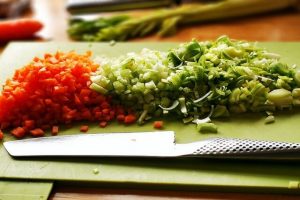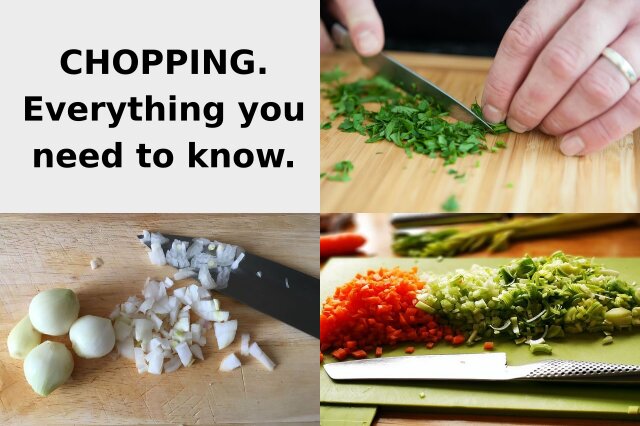If you’re new to cooking or just need a refresher, understanding the different chopping techniques can be a bit overwhelming. In this guide, we’ll break down the definition of “chop” in cooking and provide tips for chopping various ingredients, from vegetables to meats.
Understanding the Definition of Chop.
 The definition of chop in cooking is the process of cutting foods into large non-uniform pieces.
The definition of chop in cooking is the process of cutting foods into large non-uniform pieces.
The size of the chop can vary depending on the recipe and the desired texture of the dish.
Chopping is a basic cooking technique that is used for a variety of ingredients.
Onions, carrots, sweet peppers, celery, tomatoes, and potatoes are all examples of foods that are coarsely chopped to be added to stews, casseroles, soups and salads.
Other foods include meat, nuts, herbs and fruit.
It’s important to understand the different chopping techniques and when to use them to achieve the best results in your cooking.
If you are looking for the meat-cut “chop”, see Lamb-Chops or Pork-Chops for more information
Chop vs. Dice vs. Mince:
Understanding the Differences
If you’re new to cooking, you may be confused by the various terms used to describe cutting techniques.
One of the most common is “chopping,” but what does it actually mean?
In this section, we’ll explain the differences between chopping, dicing, and mincing, and provide tips for mastering each technique.
What is the difference between chopping, dicing, and mincing?
Chopping, dicing, and mincing are all techniques used to cut food into smaller pieces, but they differ in size and shape.
Chopping involves cutting food into irregular pieces, while dicing involves cutting food into uniform cubes.
Mincing involves cutting food into very small pieces, often using a sharp knife or food processor.
The technique you use will depend on the recipe and the desired texture of the final dish.
When should you use each technique?
Most of the time a recipe calls for a certain size to keep the cooking time or flavour consistent.
For example, if you chop an onion when the recipe calls for a dice, chances are the onion will not cook as the recipe intended.
Some recipes may even specify an ingredient be roughly chopped or finely chopped.
A rough or coarse chop means larger chunks of about 20mm/¾ inch, while a fine chop is much smaller at 7mm/¼ inch.
If not stated in the recipe, chopped ingredients can be anywhere from 13mm/½ inch to 20 mm/¾ inch pieces.
The technique you use will depend on the recipe and the desired texture of the final dish.
- Chopping;
Chopping yields one of the largest size pieces and is used in many recipes.It’s a good cut to use when making dishes that cook awhile, like stews, soups, and stocks.
Chopping is also great for adding texture and variety to dishes like salads or stir-fries. - Dicing;
Dicing is more uniform than chopping.
The size is also somewhat smaller. Imagine the diameter of a pea (but squared).Dicing is usually called for in a recipe where an ingredient is to be sautéed for short periods of time or eaten raw, as in salsa.
It is also perfect for recipes that require uniform pieces, like soups or stews. - Mincing;
Mincing is the smallest chop.
The texture of minced food is fine and uniform, with no large chunks or uneven pieces.This technique is often used for ingredients like garlic, onions, and herbs in recipes where a smooth texture is desired.
Mincing is also ideal for recipes that require a finer texture, like sauces or dips.
It’s important to note that the size of the food you’re cutting will also impact which technique you use.
For example, if you’re working with a large onion, you may want to chop it into smaller pieces before dicing it.
Tips for mastering each technique.
To master chopping, make sure your knife is sharp and use a rocking motion to cut through the food.
For dicing, start by cutting the food into slices, then stack the slices and cut them into even cubes.
To mince, start by finely chopping the food, then use a back-and-forth motion with the knife to create a finer texture.
Practice makes perfect, so don’t be afraid to experiment and try different techniques to find what works best for you.
How to choose the right knife for the job.
Choosing the right knife for the job is crucial when it comes to chopping, dicing, and mincing.
A chef’s knife is a versatile option that can handle all three tasks, but for more precise work, a paring knife or utility knife may be better suited.
It’s also important to make sure your knife is sharp, as a dull knife can be dangerous and make the task more difficult.
Consider investing in a sharpening tool or taking your knives to a professional for sharpening.
Common mistakes to avoid when chopping, dicing, or mincing.
One of the most common mistakes people make when chopping, dicing, or mincing is not using a sharp enough knife.
A dull knife can slip and cause injury, as well as make the task more difficult and time-consuming.
Another mistake is not using the proper technique for each task.
For example, when dicing, it’s important to make sure all the pieces are uniform in size to ensure even cooking.
Finally, not taking the time to properly prep ingredients before chopping, dicing, or mincing can lead to uneven pieces and a less-than-perfect end result.
Different Techniques for Chopping Vegetables.
Chopping vegetables is a common task in cooking, and there are several techniques you can use to achieve different results.
The most basic technique is the rough chop, where you cut the vegetable into irregular pieces of roughly the same size.
This is great for soups, stews, and stir-fries.
For a more uniform chop, you can use the dice technique, where you cut the vegetable into small cubes.
This is great for salads and salsas.
For a very fine chop, you can use the mince technique, where you cut the vegetable into very small pieces. This is great for adding flavour to sauces and dips.
How to Chop an Onion: A Step-by-Step Guide With Video
Want to master the art of onion chopping? Look no further than this step-by-step guide and video tutorial.
You’ll be dicing onions like a pro in no time.
- Cut off the ends;
Start by cutting off the top and bottom of the onion.
This will create a flat surface to work with and make it easier to peel. - Peel the onion;
Peel off the outer layer of the onion, making sure to remove any papery skin.
If the onion is particularly tough, you can score the skin with a knife to make it easier to peel. - Cut the onion in half;
Cut the onion in half from top to bottom, through the root end.
This will help keep the onion together as you chop it. - Make horizontal cuts;
Place one half of the onion flat side down on the cutting board.
Make horizontal cuts across the onion, being careful not to cut all the way through the root end.
The closer together your cuts are, the finer the chop will be. - Make vertical cuts;
Next, make vertical cuts down the onion, again being careful not to cut all the way through the root end.
The size of your vertical cuts will determine the final size of your onion pieces. - Chop the onion;
Finally, chop the onion by cutting across the vertical cuts you made earlier.
Use a rocking motion with your knife to chop the onion into small pieces. - Repeat with the other half;
Repeat the process with the other half of the onion, and you’re done!
You now have perfectly chopped onion ready to use in your favorite recipes.
How to Chop Fruits and Nuts.
Chopping fruits and nuts requires a slightly different technique than chopping vegetables.
For fruits like apples or pears, start by cutting off the top and bottom and then slicing the fruit in half.
Remove the core and then slice or dice the fruit as desired.
For nuts, use a sharp knife and a cutting board.
Place the nuts on the cutting board and use a rocking motion with the knife to chop them into small pieces.
Alternatively, you can use a food processor or blender to chop nuts quickly and easily.
Tips for Chopping Meat and Poultry.
Chopping meat and poultry can be a bit trickier than chopping fruits and vegetables.
It’s important to use a sharp knife and a sturdy cutting board to ensure safety and precision.
Start by trimming any excess fat or gristle from the meat or poultry.
Then, cut the meat into smaller pieces, such as strips or cubes, before chopping it into smaller pieces.
For poultry, be sure to remove any bones before chopping.
It’s also important to clean your knife and cutting board thoroughly after chopping meat or poultry to prevent cross-contamination.
10 Essential Tips for Perfectly Chopped Ingredients Every Time
Want to improve your chopping skills in the kitchen?
Check out these 10 essential tips for perfectly chopped ingredients every time!
While some of these tips may have been mentioned earlier in the article, they are worth reiterating as they are essential for achieving perfectly chopped ingredients every time.
Keep these tips in mind and make them a part of your chopping routine for consistently great results.
- Use a sharp knife;
A sharp knife is essential for clean and precise cuts.
A dull knife can cause uneven cuts and bruising of the ingredients. - Choose the right knife;
Different knives are designed for different tasks.
Use a chef’s knife for chopping vegetables, a serrated knife for bread, and a paring knife for small fruits and vegetables. - Use a cutting board;
A cutting board provides a stable surface for chopping and protects your countertop from scratches and damage. - Hold the knife properly;
Hold the knife with your dominant hand and grip the handle firmly.
Use your other hand to hold the ingredient steady. - Use a rocking motion;
Use a rocking motion with the knife to chop ingredients.
This motion allows for more control and precision. - Keep your fingers safe;
Curl your fingers under and use your knuckles as a guide for the knife.
This keeps your fingers safe and prevents them from getting cut. - Cut ingredients to a similar size;
Cut ingredients to a similar size to ensure even cooking and a consistent texture. - Use a claw grip;
Use a claw grip with your non-dominant hand to hold the ingredient steady and prevent it from moving while you chop. - Take breaks;
Take breaks to rest your hand and prevent fatigue. This will also help you maintain control and precision. - Practice makes perfect;
Chopping ingredients takes practice. The more you do it, the better you will become.
Don’t be afraid to experiment and try new techniques.
